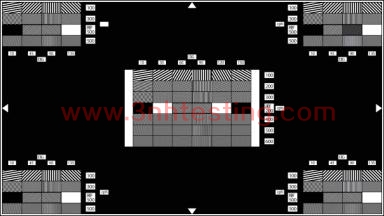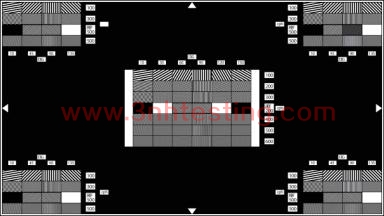HDTV RESOLUTION TEST CHART 16:9
- Introduction
- Product Software
HDTV RESOLUTION TEST CHART 16:9
REFLECTANCE

The TE118 is designed for checking the resolution characteristics of HDTV cameras. The
frequencies to be resolved are indicated in cph (cycles per height).
On a black background (mat finish; D=1.4) five fields with different line rasters and black and
white reference fields are arranged. The line rasters are inclined in different angles. Their
angular position (DEG = degree) is indicated in white fields above resp. below each row.
Frequencies are indicated on the side of each line, again in white fields. As reference values
there are 200 cph line rasters angled in 45° and 135° in each field as well as a black and a
white field (density of the white field D=0.1, referring to BaSO4). The large field located in the
center of the test chart shows line rasters of 100, 200, 300, 400, 500 and 600 cph, inclined in
angles of 10, 30, 60, 90, 120 and 150°. The fields in the four corners show line rasters of 100,
300 and 500cph, inclined in angles of 10, 45, 90 and 135°each.
On the one hand the angular position helps to avoid aliasing, on the other hand different
angular inclinations yield different resolution results with the same line rasters which may be
irregularly distributed over the picture area.
News
- 2015-05-08 PANTONE CU Color Card (Electronic E ...
- 2014-06-12 What is a colorimeter?
- 2017-06-27 Definition and formation of pixel n ...
- 2017-11-08 Attention before using T90-7 camera ...
- 2014-06-26 3nh ROHS Certificate
- 2014-06-26 3nh TUV Certificate
- 2014-06-12 Color Fastness
- 2014-06-12 Colorimeters Versus Spectrophotomet ...
.png)



.jpg)
.jpg)
.jpg)
.jpg)

